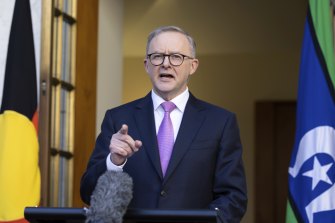Federal parliament will hammer out key details of what an Indigenous Voice to parliament will look like and when a national vote is held, Prime Minister Anthony Albanese says, in a shift from his position that much of the detail would happen after a referendum.
He has indicated the model for the Voice outlined by Professors Marcia Langton and Tom Calma in a 2021 report to the former Morrison government will be central to the debate and design.

Prime Minister Anthony Albanese during a press conference at Parliament House in CanberraCredit:alex ellinghausen
Last Saturday, Albanese announced Australians would be asked whether they supported or opposed enshrining an Indigenous Voice in the constitution, and the three sentences that would be added to what he dubbed Australia’s “birth certificate”.
On Sunday, the prime minister said much of the detail about the structure of the Voice would not be known until after the referendum was held as he wanted to avoid a repeat of the failed republic referendum in 1999 when opponents were looking at the detail of the proposal “and saying, ‘well, if you disagree with these 50 clauses, if you disagree with one out of the 50 but 49 are okay, vote no. We’re not doing that.”
But on Wednesday Albanese said he wanted to give Australians space to “walk on this journey” and discuss the proposed referendum – which the government has indicated it would like to hold before the 2025 election – and confirmed more detail would be available about the proposed model before a vote.
“I respect people having different views on this. I want a national conversation… what I did on Saturday was provide a framework for the conversation to enable it to move forward,” he said.
“We will need a referendum, legislation has to occur for that to advance, there will be a debate in the parliament as well. Inevitably, as part of that debate, there will be discussion about the extensive work of Marcia Langton and Tom Calma, extensive debate, about what a Voice to parliament might look like in terms of regional structures.”
“A particular model [has] been put forward by them that envisages a national model, but also with equal representation of male and female representatives. Particular quarantining of representation to ensure remote communities are represented and a regional structure as well… that will be advanced during the legislative debate. It will determine, when it is clearer, what an appropriate date for a referendum should be.”
